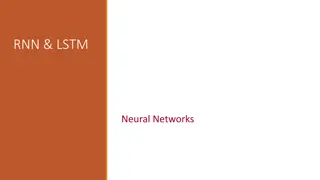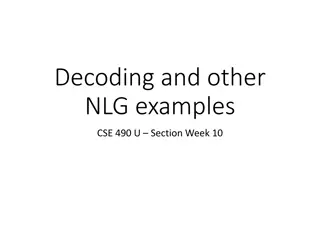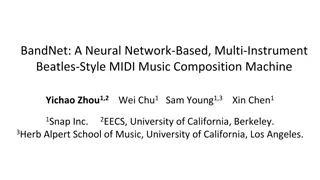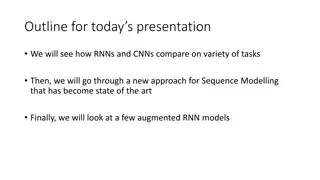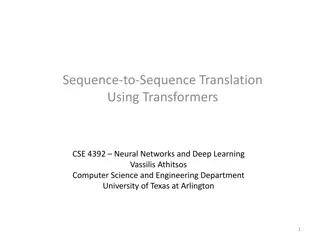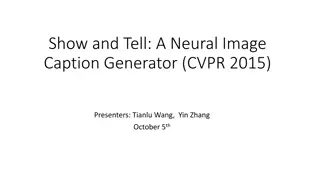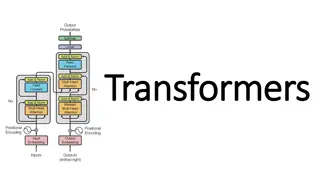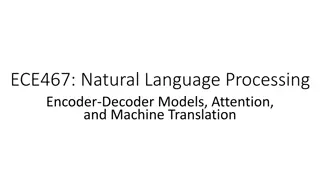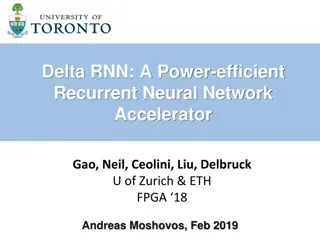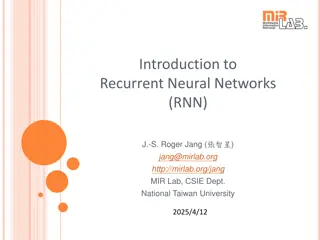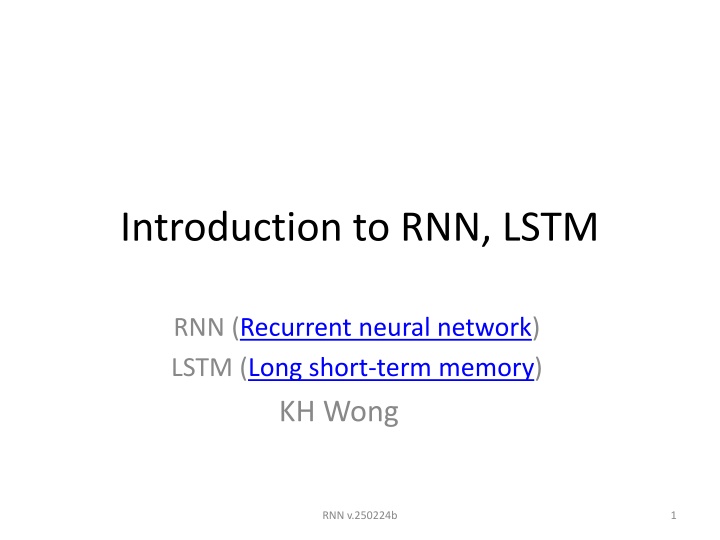
RNN and LSTM in Neural Networks
Explore the concepts of Recurrent Neural Networks (RNN) and Long Short-Term Memory (LSTM) networks, including how LSTM addresses the vanishing gradient problem. Learn how these models are used in applications like machine translation and the different types of RNN processing modes. Discover the loop that allows information to flow between time steps in RNNs.
Download Presentation

Please find below an Image/Link to download the presentation.
The content on the website is provided AS IS for your information and personal use only. It may not be sold, licensed, or shared on other websites without obtaining consent from the author. If you encounter any issues during the download, it is possible that the publisher has removed the file from their server.
You are allowed to download the files provided on this website for personal or commercial use, subject to the condition that they are used lawfully. All files are the property of their respective owners.
The content on the website is provided AS IS for your information and personal use only. It may not be sold, licensed, or shared on other websites without obtaining consent from the author.
E N D
Presentation Transcript
Introduction to RNN, LSTM RNN (Recurrent neural network) LSTM (Long short-term memory) KH Wong RNN v.250224b 1
Overview Introduction Concept of RNN (Recurrent neural network) ? The Gradient vanishing problem LSTM Long Short Term Memory LSTM theory and concept LSTM Numerical example RNN v.250224b 2
Introduction RNN (Recurrent neural network) is a form of neural networks that feed outputs back to the inputs during operation LSTM (Long short-term memory) is a form of RNN. It fixes the vanishing gradient problem of the original RNN. Application: Sequence to sequence model based using LSTM for machine translation References: Materials are mainly based on links found in https://www.tensorflow.org/tutorials https://towardsdatascience.com/illustrated-guide-to-lstms-and-gru-s-a-step-by-step-explanation- 44e9eb85bf21 RNN v.250224b 3
Concept of RNN (Recurrent neural network) concept RNN v.250224b 4
RNN Recurrent neural network Xt= input at time t ht= output at time t A=neural network The loop allows information to pass from t to t+1 reference: http://colah.github.io/posts/2015-08- Understanding-LSTMs/ RNN v.250224b 5
RNN unrolled But RNN suffers from the vanishing gradient problem to be discussed later Unroll and treat each time sample as a unit. https://www.youtube.com/watch?v=zt18u6BgdK8 RNN Animation An unrolled RNN Problem: Learning long-term dependencies with gradient descent is difficult , Bengio, et al. (1994) LSTM can fix the vanishing gradient problem RNN v.250224b 6
Different types of RNN (1) Vanilla (classical) mode of processing without RNN, from fixed-sized input to fixed-sized output (e.g., image classification). Feedforward NN (2) Sequence output (e.g., image captioning takes an image and outputs a sentence of words). (3) Sequence input (e.g., sentiment analysis where a given sentence is classified as expressing positive or negative sentiment). (4) Sequence input and sequence output (e.g. Machine Translation: an RNN reads a sentence in English and then outputs a sentence in French). (5) Synced sequence input and output (e.g. video classification where we wish to label each frame of the video). http://karpathy.github.io/2015/05/21/rnn-effectiveness/ Output layer Hidden layer (recurrent layer) Input layer (1) (2) RNN v.250224b (3) (4) (5) 7
https://imiloainf.wordpress.com/2013/11/06/rectifier-nonlinearities/https://imiloainf.wordpress.com/2013/11/06/rectifier-nonlinearities/ https://www.simonwenkel.com/2018/05/15/activation-functions-for-neural-networks.html#softplus Activation function choices Max. gradient of Signmoid is 0.25, it will cause the vanishing gradient problem Sigmoid (from 0 to 1): 1 ? ? = 1 + ? ?, ???????? =??(?) = ?(?) (1 ?(?)) ?? Tanh (from 1 to 1): ? ? =sinh(?) cosh(?)=?? ? ? ???????? ?? ?(?) =??(?) ??+ ? ?, 4 = ? ?+ ?? 2 ?? Rectified Linear Unit ???? from 0 to ,hard change : ?(?) = max(0,?), ???????? =??(?) ?? 0, Relu is now very popular and shown to be working better other methods = 1, if x 0 if x < 0 Tanh: Output is in between -1 to +1 for all input values (green line) Softplus (from 0 to ,soft change): ?(?) = ln(1 + ??),???????? =??(?) 1 = RNN v.250224b 8 1 + ? ? ??
Tanh neuron The neuron, y=output, x =input, w=weight, b=bias ? = ? u ??? ? = ?=1 ?=?? ? ? ? + ?, sinh(?) cosh(?)=?? ? ? ? ??? ? ? = tanh ? = ??+? ?, 4 ? tanh ? /?? = ? ?+?? 2 ( = i ) 1 x ( = i w ( = i w ) 1 ) 2 u ( = i ) 2 x ( ) u y f = ( ) x i I (I ) w RNN v.250224b 9
A simple RNN (recurrent Neural network) for weather (sequence) prediction (type4: many-to-many) S=Sunny; C=Cloudy; R=Rainy; T=Thundery (weather in a day) First: define the characters. The dictionary has 4 types, one-hot representation X=Use 4-bit code (one hot) to represent the weather, it means at any time, only one output is 1, others are 0. X t can be one of those {X1,X2,X3,X4}t E.g. when the input X=X1= 1000 , it is sunny Assume the training input sequence is S,C,R,T,S,C,R,T .etc. After training, predict the weather tomorrow. This mechanism (type4: many-to-many) can be extended to other applications such as machine translation One hot Encoding (X) S C R T X1 1 0 0 0 X2 0 1 0 0 X3 0 0 1 0 X4 0 0 0 1 10 RNN v.250224b
The architecture: 4 inputs(xi), 3 hidden neurons(hj), 4 outputs (sy) Only partial weights are shown to avoid crowdedness smy= softmax_out_y smy4(t) smy3(t) smy2(t) smy1(t) smy1(t) softmax softmax softmax softmax softmax y= output Why Weights =why A A Whh, size 3x3 Weights types Whh=h(t) to h(t+1) Whx=x to h Why=h to y Assume all fully connected ht+1 h(j=1,t) h(j=1,t+1) Hidden (recurrent) layer = A h(j=2,t+1) h(j=2,t) Xt Input layer h(j=3,t) ht h(j=3,t+1) Whx, size 3x4 RNN v.250224b X(i=1,t) X(i=2,t) X(i=3,t) X(i=4,t), X is of size 4x1 Hidden neurons at time t Hidden neurons at time t, which depend on xt and ht 11
A simple RNN (recurrent Neural network) for sequence prediction From t to t+1 Unroll an RNN: If S , C , R are received, the prediction is T Tanh(Whx(1,:)*Xt + Whh(1,:)*ht + bias(1) )=ht+1(1) Tanh(Whx(2,:)*Xt + Whh(2,:)*ht + bias(2) )=ht+1(2) Tanh(Whx(3,:)*Xt + Whh(3,:)*ht + bias(3) )=ht+1(3) A is an RNN with 3 neurons : After training, if you enter S , C , R step by step to Xt at each time t , the system will output T after you input Xt=3 For softmax, see http://www.cse.cuhk.edu.hk/~khwong/www2/cmsc5707/5707_likelihood.pptx Note: External output R T C Output layer (Softmax) Output layer (Softmax) Output layer (Softmax) Output layer (Softmax) Time-unrolled diagram of the RNN ht=2 ht+1 ht=3 ht=4 Hidden (recurrent) layer = tanh tanh tanh A Whx Whh Inside A, 3 neurons ht Xt=1= S Xt=2= C Xt=3= R Xt Input layer 12 RNN v.250224b https://www.analyticsvidhya.com/blog/2017/12/introduction-to-recurrent-neural-networks/
Inside A : 3 neurons at time from t to t+1, X=[X(1), X(2), X(3), X(4)] , Bias=[bias(1), bias(2), bias(3)] h=[h1,h2,h3] ht(1) Whh(1,1) ht(2) ht(3) ht+1(1) Tanh(Whx(1,:)*Xt+Whh(1,:)*ht+bias(1))=ht+1(1) Whh(1,2) Output, also feedback to neurons inputs Whh(1,3) Whx(1,4) Whx(1,2) Whx(1,3) Whx(1,1) neuron1 X(4) X(2) X(3) X(1) ht(1) ht(2) ht(3) ht+1(2) Output, also feedback to neurons inputs Whh(2,1) Tanh(Whx(2,:)* Xt +Whh(2,:)*ht+bias(2))=ht+1(2) Whh(2,2) Whh(2,3) Whx(2,2) Whx(2,3) Whx(2,4) Whx(2,1) neuron2 X(4) X(2) X(3) X(1) ht(1) ht(2) ht(3) ht+1(3) Output, also feedback to neurons inputs Whh(3,1) Tanh(Whx(3,:)* Xt +Whh(3,:)*ht1+bias(3))=ht+1(3) Whh(3,2) Whx(3,2) Whx(3,3) Whx(3,4) Whx(3,1) neuron3 Whh(3,3) 13 X(2) X(3) X(4) X(1) RNN v.250224b
Define weights whx, whh, why whx(1,1) whx(1,2) whx(1,3) whx(1,4) Input X to h output weights (not recurrent) whx(2,1) whx(2,2) whx(2,3) whx(2,4) whx= whx(3,1) whx(3,2) whx(3,3) whx(3,4) whh(1,1) Whh(1,2) Whh(1,3) Current ht to next ht+1 weights (recurrent) whh= Whh(2,1) Whh(2,2) Whh(2,3) Whh(3,1) Whh(3,2) Whh(3,3) why= why(1,1) why(1,2) why(1,3) Output ht to y_outputt weights (Not recurrent) why(2,1) why(2,2) why(2,3) why(3,1) why(3,2) why(3,3) why(4,1) why(4,2) why(4,3) 14 RNN v.250224b
whx(1,1) whx(1,2) whx(1,3) whx(1,4) whh(1,1) Whh(1,2) Whh(1,3) whx(2,1) whx(2,2) whx(2,3) whx(2,4) whx= Whh(2,1) Whh(2,2) Whh(2,3) whh= whx(3,1) whx(3,2) whx(3,3) whx(3,4) Whh(3,1) Whh(3,2) Whh(3,3) From ht(3) of neuron3 From ht(2) of neuron2 ht(1) ht(2) ht-3) ht+1(1) whh(1,1) neuron1 whh(1,2) Output, also feedback to neurons inputs whh(1,3) whx(1,4) whx(1,2) whx(1,3) whx(1,1) Zoom inside to see the connections of neuron 1 X(2) X(4) X(3) X(1) Inside view of neuron1 with connections ht(1) from neuron1 previous output ht+1(1) ht+1(1) =Tanh( whx(1,1)*Xt(1)+whx(1,2)*Xt (2)+whx(1,3)*Xt (3)+whx(1,4)*Xt (4) +whh(1,1)*ht(1)+whh(1,2)*ht(2)+whh(1,3)*ht(3) + Bias) Output, also feedback to neurons inputs neuron1 ht(2) From neuron2 previous output whx(1,3) whx(1,4) whx(1,1) whx(1,2) X(4) X(1) X(2) X(3) RNN v.250224b 15 ht(3) from neuron3 previous output
whx(1,1) whx(1,2) whx(1,3) whx(1,4) whh(1,1) Whh(1,2) Whh(1,3) whx(2,1) whx(2,2) whx(2,3) whx(2,4) whx= Whh(2,1) Whh(2,2) Whh(2,3) whh= whx(3,1) whx(3,2) whx(3,3) whx(3,4) Whh(3,1) Whh(3,2) Whh(3,3) From ht(3) of neuron3 From ht(2) of neuron2 ht(1) ht(2) ht(3) ht+1(2) whh(2,1) neuron2 whh(2,2) Output, also feedback to neurons inputs whh(2,3) whx(2,4) whx(2,2) whx(2,3) whx(2,1) Zoom inside to see the connections of neuron 2 ht(1) from neuron1 previous output X(2) X(4) X(3) X(1) Inside view of neuron1 with connections ht+1(1) =Tanh( whx(2,1)*Xt(1)+whx(2,2)*Xt (2)+whx(2,3)*Xt (3)+whx(2,4)*Xt (4) +whh(2,1)*ht(1)+whh(2,2)*ht(2)+whh(2,3)*ht(3) + Bias) ht+1(2) Output, also feedback to neurons inputs neuron2 ht(2) From neuron2 previous output whx(2,1) whx(2,3) whx(2,4) whx(2,2) X(4) X(1) X(2) X(3) RNN v.250224b 16 ht(3) from neuron3 previous output
demo_rnn4b.m: Numerical examples, give at t=0, weight/bias are initialized as: whx=[0.28 0.84 0.57 0.48 0.90 0.87 0.69 0.18 0.53 0.09 0.55 0.49]; whh =[0.41 0.12 0.13 0.51 0.24 0.26 0.61 0.34 0.36]; ht(:,1)=[0.11 0.21 0.31]'; %assume ht initially at t=1 bias=[0.51, 0.62, 0.73]';%bias initialized why=[0.37 0.97 0.83 0.39 0.28 0.65 0.64 0.19 0.33 0.91 0.32 0.14]; ht(:,t+1)=tanh(whx*in(:,t)+whh*ht(:,t)+bias) % //// eqn.for h(t+1) /////////////////// Exercise 1a, if X=[1,0,0,0] MC question: choices: find ht=2(1)=_____? (1) tanh(0.28*1+0.84*0+ 0.57*0+ 0.48*0+ 0.41*0.11+0.12*0.21+0.13*0.31+ 0.51) (2) tanh(0.28*0+0.84*1+ 0.57*0+ 0.48*0+ 0.41*0.11+0.12*0.21+0.13*0.31+ 0.51) (3) tanh(0.28*0+0.84*0+ 0.57*1+ 0.48*0+ 0.41*0.11+0.12*0.21+0.13*0.31+ 0.51) (4) tanh(0.28*0+0.84*0+ 0.57*0+ 0.48*1 0.41*0.11+0.12*0.21+0.13*0.31+ 0.51) Exercise 1b : find ht=2(2)=___? , Exercise 1c : find ht=2(3)= ___? whx(1,1) whx(1,2) whx(1,3) whx(1,4) whx(2,1) whx(2,2) whx(2,3) whx(2,4) whx= whx(3,1) whx(3,2) whx(3,3) whx(3,4) whh(1,1) Whh(1,2) Whh(1,3) whh= Whh(2,1) Whh(2,2) Whh(2,3) Whh(3,1) Whh(3,2) Whh(3,3) 17 RNN v.250224b
Step1 find initialized ht=1 %Explanation of how to find answer of Ex.1a, ht=2(1),ht=2(2), ht=2(3) %To find output at t=2, %Equation:X=[1,0,0,0] ht(1,t+1)= Tanh( Whx(1,1)*Xt(1)+Whx(1,2)*Xt(2)+Whx(1,3)*Xt(3) +Whx(1,4)*Xt (4) +Whh(1,1)*(h1)+Whh(1,2)*(h2)+Whh(1,3)*(h3 ) + bias(1)) Exercise 1a, MC question: choices: find ht=2(1)=_____? (1) tanh(0.28*1+ 0+0+0+ 0.41*0.11+0.12*0.21+0.13*0.31+ 0.51) = 0.7166 (2) tanh(0+0.84*1+0+0+ 0.41*0.11+0.12*0.21+0.13*0.31+ 0.51) (3) tanh(0+0+0.57*1+0+ 0.41*0.11+0.12*0.21+0.13*0.31+ 0.51) (4) tanh(0+0+0+0.48*1+ 0.41*0.11+0.12*0.21+0.13*0.31+ 0.51) (choice 1 is correct) ht=2(1)= 0.7166 Ans. For Exercise0.1a, b,c At time t=1 ,X= 1 0 0 0 whx=[0.28 0.84 0.57 0.48 0.90 0.87 0.69 0.18 0.53 0.09 0.55 0.49]; whh =[0.41 0.12 0.13 0.51 0.24 0.26 0.61 0.34 0.36]; ht(:,1)=[0.11 0.21 0.31]; %assume ht initially at t=1 bias=[0.51, 0.62, 0.73]';%bias initialized time t=1 ,X= [1,0,0,0] ht=2(2)= tanh(0.90*1+ 0+0+0+ 0.51*0.11+0.24*0.21+0.26*0.31+ 0.62) =0.9363 ht=2(3)= tanh(0.53*1+ 0+0+0+ 0.61*0.11+0.34*0.21+0.36*0.31+ 0.73)=0.9070 RNN v.250224b 18 h_2=[0.7166,0.9363,0.9070]
Recall ht(:,2)=[0.7002, 0.9321, 0.9009] why= why(1,1) why(1,2) why(1,3) why(2,1) why(2,2) why(2,3) Exercise 2 : After ht(:,2) is found , find y_out Look at the output network, it finds y_out() from h() y_out(1)=why(1,1)*ht(1)+why(1,2)*ht(2)+ why(1,3)*ht(3) y_out(2)=why(2,1)*ht(1)+why(2,2)*ht(2)+ why(2,3)*ht(3) y_out(3)=why(3,1)*ht(1)+why(3,2)*ht(2)+ why(3,3)*ht(3) y_out(4)=why(4,1)*ht(1)+why(4,2)*ht(2)+ why(4,3)*ht(3) h , y_out are fully connected so Weights(the why variable)=(4x3) why(3,1) why(3,2) why(3,3) why(4,1) why(4,2) why(4,3) y_out(1) (2) (3) (4) why=[0.37 0.97 0.83 0.39 0.28 0.65 0.64 0.19 0.33 0.91 0.32 0.14]; %h_2=[0.7166,0.9363,0.9070] ht=[0.7166,0.9363,0.9070] Y_out=why*ht= 1.9262 1.1312 0.9358 1.0787 (This SoftMax output network requires no bias, but can add bias =1 to make resulst stable. See the chapter on cnn for details) ht(1) ht(2) ht(3) RNN v.250224b 19
Answer for Ex2 Softmax is to make sum_all_i{softmax[y_out(i)]}=1 ,each softmax[y_out(i)] is a probability [ 0.4441 0.2006 0.1650 0.1903] A=exp(1.9262) B=exp(1.1312) C=exp(0.9358) D=exp(1.0787) tot=A+B+C+D soft_max_y_out(1)=A/tot; soft_max_y_out(2)=B/tot; soft_max_y_out(3)=C/tot; soft_max_y_out(4)=D/tot; soft_max_y_out 0.4441 0.2006 0.1650 0.1903 This is to make Softmax is a probability (sum of the above vector is 1) Softmax_y_out(1) (2) (3) (4) exp( = _ ) y out = softmax ( _ ) , i y out The output layer i n exp( _ ) y out i 1 i = for 1 2 ,.. i , ,n 1.9262 1.1312 0.9358 1.0787 y_outi=1,2,3,4 h , Y_out are fully connected so Weights(the why variable)=(4x3) (This output network requires no bias) ht(2)= 0.9321 ht(3)= 0.9009 ht(1)= 0.7002 RNN v.250224b 20
After y_out is is found , find softmax_y_out Look at the softmax output module it transforms y_out() to softmax_y_out() 1) each softmax_y_out is positive, 2) each softmax_y_out is negative, 3) each softmax_y_out is a probability 4) each softmax_y_out is smaller than 2. A1=exp(y_out(1)) A2=exp(y_out(2)) A3=exp(y_out(3)) A4=exp(y_out(4)) Tot=A1+A2+A3+A4 Softmax_y_out(1)=A1/Tot Softmax_y_out(2)=A2/Tot Softmax_y_out(3)=A3/Tot Softmax_y_out(4)=A4/Tot Exercise 3 MC question: This stage is to make sure Softmax_y_out(1) (2) (3) (4) exp( = _ ) y out = softmax ( _ ) , i y out i n exp( _ ) y out i 1 i = for 1 2 ,.. i , ,n y_out(1) (2) (3) (4) (This output network requires no bias) ht(1) ht(2) ht(3) 21 RNN v.250224b
Answer of ex3 is choice 3:each softmax_y_out is a probability Calculate recurrently for t=1,2,3,4 Assume the training input sequence is S,C,R,T,S,C,R,T .etc. When t=1, input is S , so x(1)=1,x(2)=0,x(3)=0,x(4)=0 [i.e.X=1000] Find ht=1(1), ht=1(2), ht=1(3), (shown before) Then for t=2, input is C , use X=0100] and also the current weights and h values Find ht=2(1), ht=2(2), ht=2(3), and so on After ht=2(1), ht=2(2), ht=2(3) are found calculate softmax_y_out at time t=3 , is [ 0.4441 0.2006 0.1650 0.1903] Calculate recurrently until you find all h and softmax output values. They will be used for training See the program in the next slide One hot Encoding (X) S C R T X1 1 0 0 0 X2 0 1 0 0 X3 0 0 1 0 X4 0 0 0 1 RNN v.250224b 22
Ans. 1,2,3(overall result) %MatlabDemo rnn4b.m modified f2023 Dec30a %https://stackoverflow.com/questions/50050056/simple- rnn-example-showing-numerics %https://www.analyticsvidhya.com/blog/2017/12/introdu ction-to-recurrent-neural-networks/ clear, %clc in_S=[1 0 0 0]'; in_C=[0 1 0 0]'; in_R=[0 0 1 0]'; in_T=[0 0 0 1]'; X=[in_S,in_C,in_R, in_T]; %assume whx,whh,why are initialised at t=1 as whx=[ 0.28 0.84 0.57 0.48 0.90 0.87 0.69 0.18 0.53 0.09 0.55 0.49]; whh =[0.41 0.12 0.13 0.51 0.24 0.26 0.61 0.34 0.36]; why=[ 0.37 0.97 0.83 0.39 0.28 0.65 0.64 0.19 0.33 0.91 0.32 0.14]; bias=[0.51, 0.62, 0.73]';%bias initialised ht(:,1)=[0.11 0.21 0.31]'; %assume ht has value initally at t=1 %Forward pass only, %for t = 1:length(in)-1 % %(y_out not feedback to network, only h feeback to network) y_out(:,1)=why*ht(:,1);%the outputs at t=1 (inital value) softmax_y_out(:,1)=softmax(y_out(:,1)); %outputs at t=1(init) for t = 1:3 % assume we want to see 3 steps ht(:,t+1)=tanh( whx*X(:,t)+whh*ht(:,t)+bias); %recurrent layer y_out(:,t+1)=why*ht(:,t+1) ; softmax_y_out(:,t+1)=softmax(y_out(:,t+1)); %output layer end %'print result =================== X, ht, y_out, softmax_y_out print result =================== X = 1 0 0 0 0 1 0 0 0 0 1 0 0 0 0 1 ht = 0.1100 0.7166 0.9540 0.9370 0.2100 0.9363 0.9807 0.9793 0.3100 0.9070 0.9564 0.9876 y_out = 0.5017 1.9261 2.0981 2.1164 0.3032 1.1312 1.2683 1.2816 0.2126 0.9358 1.1125 1.1117 0.2107 1.0787 1.3158 1.3043 softmax_y_out = 0.3015 0.4441 0.4412 0.4456 0.2472 0.2006 0.1924 0.1934 0.2258 0.1650 0.1646 0.1632 0.2254 0.1903 0.2018 0.1978 T = 1 2 3 4 Time RNN v.250224b 23
Discussion: Output layer: softmax Assume you train this network using SCRTSCRT, SCRT,.. etc One hot Encoding (X) S C R T Prediction is achieved by seeing which y_out is biggest after the softmax processing of the output layer softmax_y_out = Time= 1 2 3 0.3015 0.4441 0.4412 0.4456 0.2472 0.2006 0.1924 0.1934 0.2258 0.1650 0.1646 0.1632 0.2254 0.1903 0.2018 0.1978 4 y X1 1 0 0 0 X2 0 1 0 0 X3 0 0 1 0 X4 0 0 0 1 From the above result, at t=3 prediction is S =[high,low,low,low]=[1,0,0,0] which is not correct, it should be T . Why? Because at t=1, predicted output should be C , then at t=2, output should be R , at t=3 output should be T . Here weights are just randomly initialized in this example, so currently predict is wrong. After training, the prediction should be fine. , i y i 1 = For softmax, see http://www.cse.cuhk.edu.hk/~khwong/www2/cmsc5707/5707_likeli hood.pptx exp( ) y = = softmax ( ) , for 1 2 ,.. i y ,n i n exp( ) i RNN v.250224b 24
How to train a recurrent Neural net RNN S=Sunny; C=Cloudy; R=Rainy; T=Thundery (average weather in a day) After unrolled the RNN, it becomes a Feedforward neural network Give sequence samples, say 3 years=(365*3) days samples E.g. S,C,R,T,S,C,R,T,S,C,R,T SSCRT (mostly the sequence of SCRT,SCRT) Train by backpropagation, the rule: If Xt=1 is the INPUT then Xt=2 is the TARGET e.g. input = S (Xt=1 =1000), output is at the softmax output, and target is C (Xt=2 =0100), or, in another example case, if input = R (Xt=1 =0010), output is at the softmax output, and target is T (Xt=2 =0001) After unroll the RNN, we will use : (1) input, (2) output(softmax output) and (3) target, to train weights/biases as if it is a feedforward network (discuss before) Ideally, after successfully trained the RNN, if SCR for 3 consecutive days are observed, the weather prediction for the next day is T ht+1 Softmax Softmax h = Ot= encoder hidden vector is generated after a sequence is entered. You will see that it will be used for machine translation target= T target= R target= C Target Softmax ht=2 ht=3 ht=4 A = tanh tanh tanh ht Xt Xt=2= C Xt=1= S Time-unrolled diagram of the RNN Xt=3= R Xt=1 is the input, Xt=2 is the target, RNN v.250224b 25
Problem with RNN: The vanishing gradient problem Ref: https://hackernoon.com/exploding-and-vanishing-gradient-problem-math-behind-the-truth- 6bd008df6e25 RNN v.250224b 26
The maximum of derivative of sigmoid is 0.25, Hence feedback will vanish when the number of layers is large. sigmoid Problem with RNN: The vanishing gradient problem 0.25 During backpropagation, signals are fed backward from output to input using gradient-based learning methods In each iteration, a network weight receives an update proportional to the gradient of the error function with respect to the current weight. In theory, the maximum gradient is less than 1 (max derivative of sigmoid is 0.25). So, the learning signal is reduced from layer to layer. In RNN, after unrolled the network, the difference between the target and the output of the last element of the sequence has to back-propagate to update the weights/biases of all the previous neurons. The backpropagation signal will be reduced to zero if the training sequence is long. It also happens to a feedforward neural network with many hidden layers (deep net). RNN v.250224b 27
Recall the weight updating process by gradient decent in Back-propagation (see previous lecture notes) Case1: w in Back-propagation from output layer (L) to hidden layer ( , n m w ) ( 1 ) e = 1 L n L n L n L n L m ( ) ( ) n x t f u f u x L w=(output-target)*dsigmoid(f)*input to w w= sensitivity L *input to w Case 2: w in Back-propagation a hidden layer to the previous hidden layer 1 , = k n m w Input to w Gradient of sigmoid (disgmoid) e ( 1 ) = k K 2 L = 1 1 L k L n L n L n ( ) ( ) w f u f u x , k i 1 L w= L-1 sensitivity L-1 will be used for the layer in front of layer L-1, .. etc *input to w Cause of the vanishing gradient problem : Gradient of the activation function (sigmoid here) is less then 1, so the back-propagated values may diminish if more layers are involved RNN v.250224b 28
Popular neuron activation functions https://imiloainf.wordpress.com/2013/11/06/rectifier-nonlinearities/ https://www.simonwenkel.com/2018/05/15/activation-functions-for-neural-networks.html#softplus Max. gradient of Signmoid is 0.25, it can cause the vanishing gradient problem Sigmoid (from 0 to 1): 1 ? ? = 1 + ? ?, ???????? =??(?) = ?(?) (1 ?(?)) ?? Tanh (from 1 to 1): ? ? =sinh(?) cosh(?)=?? ? ? ???????? ?? ?(?) =??(?) ??+ ? ?, 4 = ? ?+ ?? 2 ?? Rectified Linear Unit ???? from 0 to ,hard change : ?(?) = max(0,?), ???????? =??(?) ?? = 1, if x 0 if x < 0 0, RNN v.250224b 29
Advantages of these activation functions Sigmoid :output range from 0 to 1, good to model probability. Tanh: Max. gradient is 4 times greater than that of sigmoid. Using Tanh can help to reduce the gradient vanishing problem. Popular for building RNN. Relu: The gradient is 1 which can reduce the gradient vanishing problem. It is computationally efficient, and popular for building hidden layers. 1 Tanh gradient Sigmoid gradient 0.25 30 RNN v.250224b https://www.baeldung.com/cs/sigmoid-vs-tanh-functions
To solve the vanishing gradient problem, LSTM adds C (cell state) RNN has xi(input) and ht(output) only In LSTM (Long Short Term Memory), add Cell state (Ct) to solve gradient vanishing problem In each time (t), updates Ct=cell state (ranges from -1 to 1) ht= output (ranges from 0 to 1) The system learns Ct and ht together RNN v.250224b 31
LSTM (Long short-term memory) Standard RNN Input concatenate with output then feed to input again LSTM The repeating structure is more complicated (the complexity is 4 times of the standard RNN) RNN v.250224b 32
Conclusion We studied the basic structure of Recurrent Neural Networks (RNN) and its applications The neural network vanishing problem is discussed. The solution of the vanishing gradient problem using LSTM (Long short-term memory) is discussed. RNN v.250224b 33
References Deep Learning Book. http://www.deeplearningbook.org/ Papers: Fully convolutional networks for semantic segmentation by J Long, E Shelhamer, T Darrell Sequenceto sequencelearning with neural networks by I Sutskever, O Vinyals, QV Le- tutorials http://colah.github.io/posts/2015-08-Understanding-LSTMs/ https://github.com/terryum/awesome-deep-learning-papers turtorial: https://theneuralperspective.com/tag/tutorials/ RNN encoder-decoder https://theneuralperspective.com/2016/11/20/recurrent-neural-networks-rnn-part-3-encoder-decoder/ sequence to sequence model https://arxiv.org/pdf/1703.01619.pdf https://indico.io/blog/sequence-modeling-neuralnets-part1/ https://medium.com/towards-data-science/lstm-by-example-using-tensorflow-feb0c1968537 https://google.github.io/seq2seq/nmt/ https://chunml.github.io/ChunML.github.io/project/Sequence-To-Sequence/ parameters of lstm https://stackoverflow.com/questions/38080035/how-to-calculate-the-number-of-parameters-of-an-lstm-network https://datascience.stackexchange.com/questions/10615/number-of-parameters-in-an-lstm-model https://stackoverflow.com/questions/38080035/how-to-calculate-the-number-of-parameters-of-an-lstm-network https://www.quora.com/What-is-the-meaning-of-%E2%80%9CThe-number-of-units-in-the-LSTM-cell https://www.quora.com/In-LSTM-how-do-you-figure-out-what-size-the-weights-are-supposed-to-be http://kbullaughey.github.io/lstm-play/lstm/ (batch size example) feedback https://medium.com/@aidangomez/let-s-do-this-f9b699de31d9 Numerical examples https://blog.aidangomez.ca/2016/04/17/Backpropogating-an-LSTM-A-Numerical-Example/ https://karanalytics.wordpress.com/2017/06/06/sequence-modelling-using-deep-learning/ http://monik.in/a-noobs-guide-to-implementing-rnn-lstm-using-tensorflow/ RNN v.250224b 34

